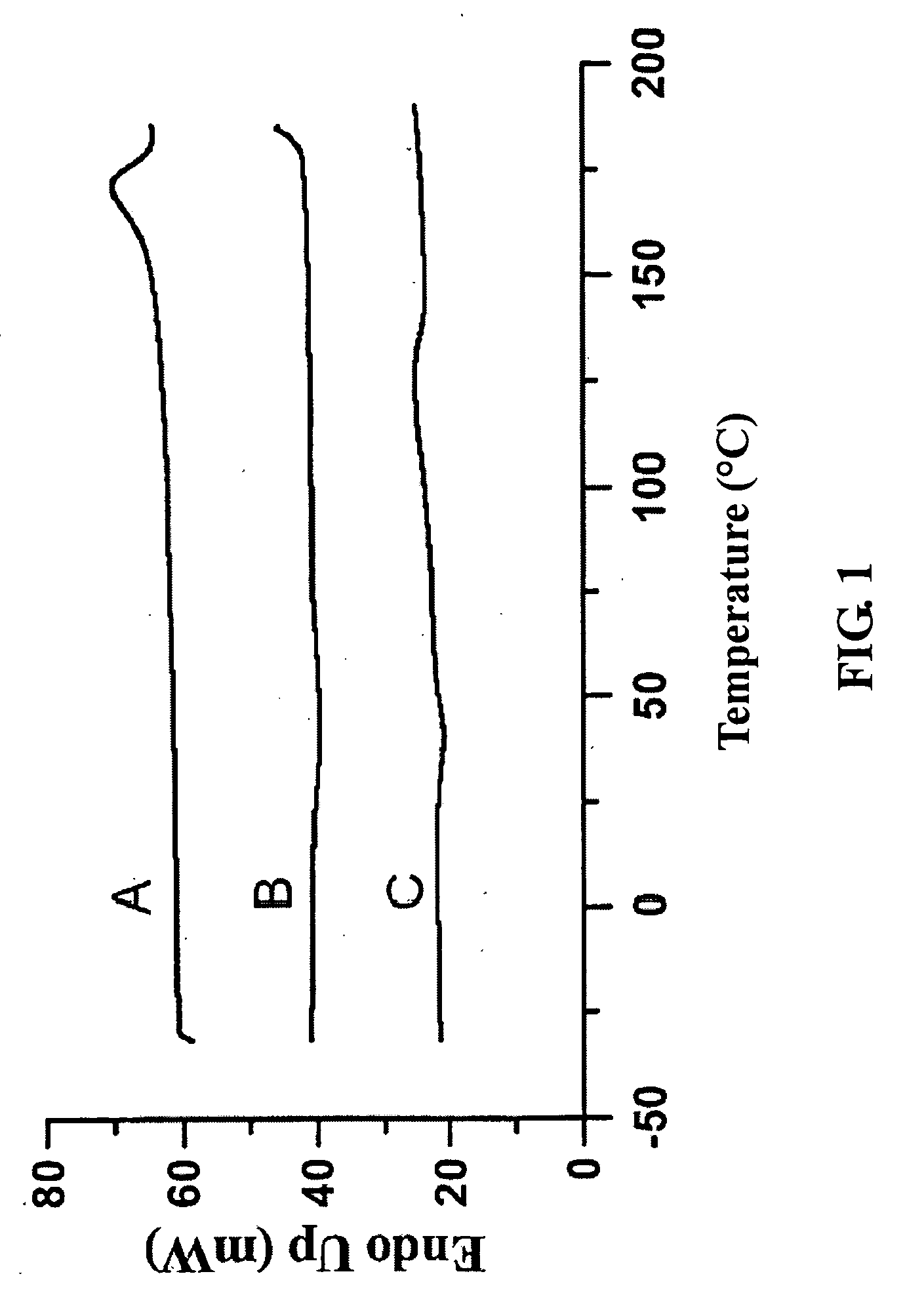Method of improving thermal stability of poly-3-hydroxybutyrate
a technology of hydroxybutyrate and thermal stability, applied in the field of improving thermal stability, can solve the problems of difficult reduction of molecular weight by heat treatment, difficult generation of scission degradation of phb grafted with mechanical grafting method, etc., and achieve the effect of improving thermal stability and poor thermal stability
- Summary
- Abstract
- Description
- Claims
- Application Information
AI Technical Summary
Benefits of technology
Problems solved by technology
Method used
Image
Examples
example 1
Melt Grafting Method
[0017](1) 50 g of PHB (purity 98%, average molecular weight 605000, dispersion rate 1.56) was added maleic anhydride (MA) and initiator benzoyl peroxide (BPO) in a different ratio (i.e. 5 Phr MA+1 Phr BPO) (phr: parts per hundred). The mixture was processed at 5 kg-m (100 rpm) for 10 min after preheated at 175° C. for 2 min in a Brabender PL2000 Plasticorder.
[0018](2) The processed sample was ground and rinsed with acetone to wash out the un-reacted MA and initiators, then dried in a hood.
[0019](3) The grafting degree of MA was 1.54% after reaction when analyzed with a GC.
[0020](4) The grafting degree of MA was 1.44% after reaction when carried out in the ratio of 10 to 1 (10 Phr MA+1 Phr BPO) and analyzed with a GC.
example 2
Solution Grafting Method
[0021](1) 1 g of PHB was added 5 Phr of MA and one Phr of BPO dissolved in 20 ml of chloroform. The mixture was stirred at 55° C. for 6 hr in an oil bath.
[0022](2) Fifteen ml of the processed sample was placed in a glass plate and the solvent was evaporated in a hood for 24 hr.
[0023](3) Another 15 ml of the sample was added with 30 ml of methanol in drops through purification steps to recover PHB, which was washed with acetone several times and dried in a hood.
[0024](4) The grafting degree of MA was 0.07% after reaction when analyzed with a GC.
example 3
Mechanical Grafting Method
[0025](1) 50 g of PHB was added MA and initiator BPO in different ratio (i.e. Phr MA+1 Phr BPO). The mixture was processed at 300 rpm for 10 hr in a Restch type 51 vibratory ball mill.
[0026](2) The processed sample was rinsed with acetone several times to wash out the un-reacted MA and initiators, then dried in a hood.
[0027](3) The grafting degree of MA was 0.12% after reaction when analyzed with a GC.
[0028](4) The grafting degree of MA was 0.26% after reaction when carried out in the ratio of 10 to 1 (10 Phr MA+1 Phr BPO) and analyzed with a GC.
A. DSC (Differential Scanning Calorimetry) Analysis of Grafted Samples
[0029](1) The instrument system was purged with nitrogen at a flow rate of 40 ml / min and equilibrated for several min. 5-10 mg of samples were weighed and pressed into tablet in aluminum DSC pans.
[0030](2) The temperature was increased from −40° C. to 185° C. at the rate of 10° C. / min and stayed at 185° C. for 5 min to eliminate different heat his...
PUM
| Property | Measurement | Unit |
|---|---|---|
| molecular weight | aaaaa | aaaaa |
| temperature | aaaaa | aaaaa |
| flow rate | aaaaa | aaaaa |
Abstract
Description
Claims
Application Information
 Login to View More
Login to View More - R&D
- Intellectual Property
- Life Sciences
- Materials
- Tech Scout
- Unparalleled Data Quality
- Higher Quality Content
- 60% Fewer Hallucinations
Browse by: Latest US Patents, China's latest patents, Technical Efficacy Thesaurus, Application Domain, Technology Topic, Popular Technical Reports.
© 2025 PatSnap. All rights reserved.Legal|Privacy policy|Modern Slavery Act Transparency Statement|Sitemap|About US| Contact US: help@patsnap.com



